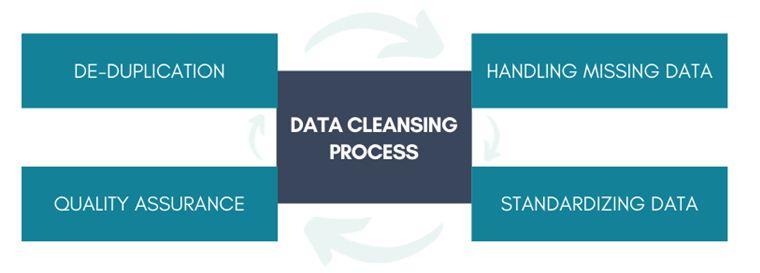Data needs to be correct, consistent, and usable to make the right decisions. Data is integral to any organization’s smooth running. Over time, businesses collect and store a lot of data from their customers and prospects, and also have to deal with their employee data, data related to acquisitions, partnerships, agreements, consumer interactions and engagement sand so on. Manually collected data can be confusing, with numerical and spelling mistakes, unnecessary duplicates, or outdated data. Often, businesses as well as individuals have a hard time cleaning up their data mainly because they tend to leave their data for too long without attending to it, which leads to unwanted data accumulating.
So, how can businesses ensure clean data in their databases? The practical solution is to hire data cleansing services from reliable providers.
What is Data Cleansing?
Data cleansing or cleaning is the process of correcting, fixing or removing inaccurate, inconsistent, duplicate or incomplete data in the business database and making the data completely usable and easily accessible for users. Also referred to as data scrubbing and data cleaning, data cleansing ensures the consistency, reliability, and value of your business or individual data.
Cleaning data involves filling in standardized data, identifying and fixing errors and missing values, removing wrong data, properly formatting data, determining if all the information is in the right rows and columns, and compiling all clean data in one area.
The major types of dirty data that can pollute the database are duplicate data from manual entry or batch imports, outdated or irrelevant data that was collected long back, insecure data that does not comply with standard laws and regulations, incomplete data that lacks key details, incorrect or inaccurate data with wrong information, or even non-standardized data with poor data structure.
Why Maintain Clean Data?
It is estimated that around 3% of data gets decayed every month and about 14% revenue loss happens each year due to poor data quality. (Blue Mail Media)
Dirty data or data that contains errors can cause many losses to your business. It can impact your brand’s bottom line.
- You may take the wrong business decisions
- Data scientists take more time to clean data
- Sales team finds it difficult to trace the lead source
- Wrong records due to wrong updates on emails, which dissatisfies customers
- Unnecessary costs related to managing duplicate records
- Consumption of a lot of data storage space in servers
Common errors and inconsistencies in data include missing values, typographical errors and misplaced entries. Incorrect or contradictory data can lead to wrong conclusions. Clean, up-to-date data delivers better quality leads and boosts sales.
Accurate data is especially important for businesses’ data-driven marketing. Data cleansing offers diverse data quality-related benefits such as –
- Improved decision making
- Improved data quality
- Increased overall productivity
- Saves you time and money
- Helps understand your customers better
- Creates new business opportunities
- Protects your reputation
When outdated or incorrect information is removed, and only the highest quality information is maintained, your employees no longer have to wade through countless outdated documents.
Data Cleansing Process
Here is a step-by-step process to get clean data.
De-duplication
Duplicate observations will often happen during data collection. Entering the data twice or leaving it incomplete can result in errors. Removing duplicate or irrelevant observations is the key to efficient and accurate business processes.
Handling Missing Data
While conducting a survey or while collecting data, you may fail to add values in columns. To deal with missing data, either add the data based on other data patterns and observations, highlight the missing value, or ignore the entire column in which the data is missing.
Standardizing Data
Make sure to fix any structural issues and standardize data rules that define cross-organizational structures, and then stick to them rigorously. Decide which data is used most often, the time you need that, and who will be responsible for maintaining the process. Make sure to correct inconsistent punctuation, typos and mislabeled classes and categories. Check for any inconsistencies such as misalignments, contradictions or gaps in data.
Quality Assurance Checks
The next step is to re-check and ensure data accuracy.
Once the data is corrected and cleaned, and any structural issues sorted out, the next step is to perform manual quality assurance checks before starting data analysis. Perform the final QA check and examine whether there are any anomalies in data. Double-check to make sure that the data is formatted correctly.
| Read our blog |
Best Practices
- Make sure to clean data regularly
- For large datasets, make sure to limit sample size, which helps minimize prep time and accelerate performance
- Choose software solutions that can resolve problematic data corrections and mistakes
- Implement a better quality assurance check to ensure data accuracy
- Develop a data quality strategy that works to identify incorrect data and maintain data hygiene on an ongoing basis
Data Cleaning Tools
Many organizations are also investing in advanced data cleansing tools to clean up data on their own. Such tools can make the data preparation and scrubbing process simpler. There are tools that can reduce manual inspection and thus streamline the process.
Diverse data scrubbing tools are available to audit and inspect data, remove duplicate data, and identify any formatting issues and general errors. However, when the data is cleaned, you need to manually verify whether the results adhere to all standards and regulations. The verified results can be converted into a report, which can be used to avoid any future data issues.
Check out some of the effective data cleansing tools
- Trifacta Wrangler
- TIBCO Clarity
- Data Ladder
- Cloudingo
- Xplenty
- Melissa Clean Suite
- WinPure Clean & Match
- RingLead
| Also Read |
Why Outsource Data Cleaning Tasks?
The major challenges that companies face while dealing with data cleaning tasks include lack of resources to perform data scrubbing, limited knowledge on what is causing data errors, failing to create a perfect data quality plan, not disposing useless data, etc.
Buying data cleansing tools or hiring additional in-house staff to clean and manage accurate data is expensive, especially for small businesses. A cost-effective option is to partner with experienced data cleansing service providers that can turn even messed-up or complicated ata into reliable information. The provider must have a dedicated team to check for duplicate records and format data in a way that suits your business or individual requirements.
| Read |
How MOS can Help
We know that cleaning large-volume data is time-consuming and requires comprehensive data management efforts. At Managed Outsource Solutions, we provide customized data cleansing services that are dedicated to improving data quality in all formats, let that be offline or online data, CRM data, or social media data. Our team ensures clean data by identifying individual data elements in the file, correcting wrong details with sophisticated data algorithms, converting them into a standard format, matching records with the standardized data, checking duplicate data, and merging cleaned data into one.
By outsourcing your data scrubbing tasks to MOS, you can benefit from quick turnaround time, better quality assurance, state-of-the-art technology, services from an expert professional team on each project, strict file security measures, and competitive pricing.
Need help with data cleansing? Talk to us at 1-800-670-2809!





